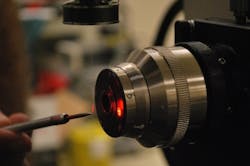Photoacoustic sensor simultaneously detects five different nerve agents
Adelphi, MD--A photoacoustic sensor developed at the U.S. Army Research Laboratory (ARL) can simultaneously detect multiple nerve agents. The device uses laser photoacoustic spectroscopy (LPAS, a combination of a laser and sensitive microphones) to detect sarin and other odorless, colorless agents at parts per billion or even parts per trillion levels.1
The drawback of traditional LPAS systems is that they can identify only one chemical at a time. “Photoacoustics is an excellent analytic tool, but is somewhat limited in the sense that one traditionally only measures one absorption parameter at a time,” says Kristan Gurton, an ARL researcher. “As I started looking into the chemical/biological detection problem, it became apparent that multiple LPAS absorption measurements -- representing an absorption spectrum -- might provide the added information required in any detection and identification scheme.”
To create such a multiwavelength LPAS system, Gurton, along with coauthors Melvin Felton and Richard Tober of the ARL, designed a cylindrical photoacoustic cell that allows different gases to flow through the device for testing. As the vapor of five nerve-agent mimics is flowed in, three laser beams, each modulated at a different frequency in the acoustic range, are propagated through the cell.
“A portion of the laser power is absorbed, usually via molecular transitions, and this absorption results in localized heating of the gas,” says Gurton. "Since gas dissipates thermal energy fairly quickly, the modulated laser results in a rapid heat/cooling cycle that produces a faint acoustic wave,” which is picked up by the microphone. Each laser in the system will produce a single tone, so, for example, six laser sources have six possible tones. “Different agents will affect the relative ‘loudness’ of each tone,” he says, “so for one gas, some tones will be louder than others, and it is these differences that allow for species identification.”
Before a device based on the technique could be used in the field, Gurton says, a quantum cascade laser (QCL) array with at least six well-chosen mid-IR laser wavelengths would need to be available. “There are groups of researchers producing QCL arrays that will operate with sufficient power, and will house as many as 10 -- or more -- lasers at different frequencies in the spectroscopically rich region of the mid-IR,” he says.
A sufficiently rugged device for in-the-field use could be about the size of a milk carton.
Reference:
1. Kristan P. gurton et al., Optics Letters, Vol. 37, Issue 16, p. 3474 (2012).
About the Author
John Wallace
Senior Technical Editor (1998-2022)
John Wallace was with Laser Focus World for nearly 25 years, retiring in late June 2022. He obtained a bachelor's degree in mechanical engineering and physics at Rutgers University and a master's in optical engineering at the University of Rochester. Before becoming an editor, John worked as an engineer at RCA, Exxon, Eastman Kodak, and GCA Corporation.

